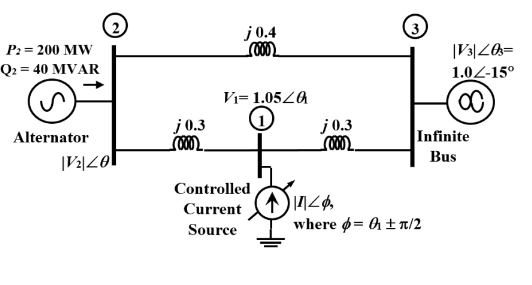The three-bus power system shown in the figure has one alternator connected to bus $2$ which supplies $200 \mathrm{MW}$ and $40 \text{MVAr}$ power. Bus $3$ is infinite bus having a voltage of magnitude $\left|V_3\right|=1.0$ p.u. and angle of $-15^{\circ}$. A variable current source, $|I| \angle \phi$ is connected at bus $1$ and controlled such that the magnitude of the bus $1$ voltage is maintained at $1.05 \; p.u.$ and the phase angle of the source current, $\phi=\theta_1 \pm \frac{\pi}{2}$, where $\theta_1$ is the phase angle of the bus $1$ voltage. The three buses can be categorized for load flow analysis as

- Bus $1 \quad$ Slack bus
Bus $2 \quad P-|V|$ bus
Bus $3 \quad P-Q$ bus
- Bus $1 \quad P-|V|$ bus
Bus $2 \quad P-|V|$ bus
Bus $3 \quad$ Slack bus
- Bus $1 \quad P-Q$ bus
Bus $2 \quad P-Q$ bus
Bus $3 \quad$ Slack bus
- Bus $1 \quad P-|V|$ bus
Bus $2 \quad P-Q$ bus
Bus $3 \quad$ Slack bus